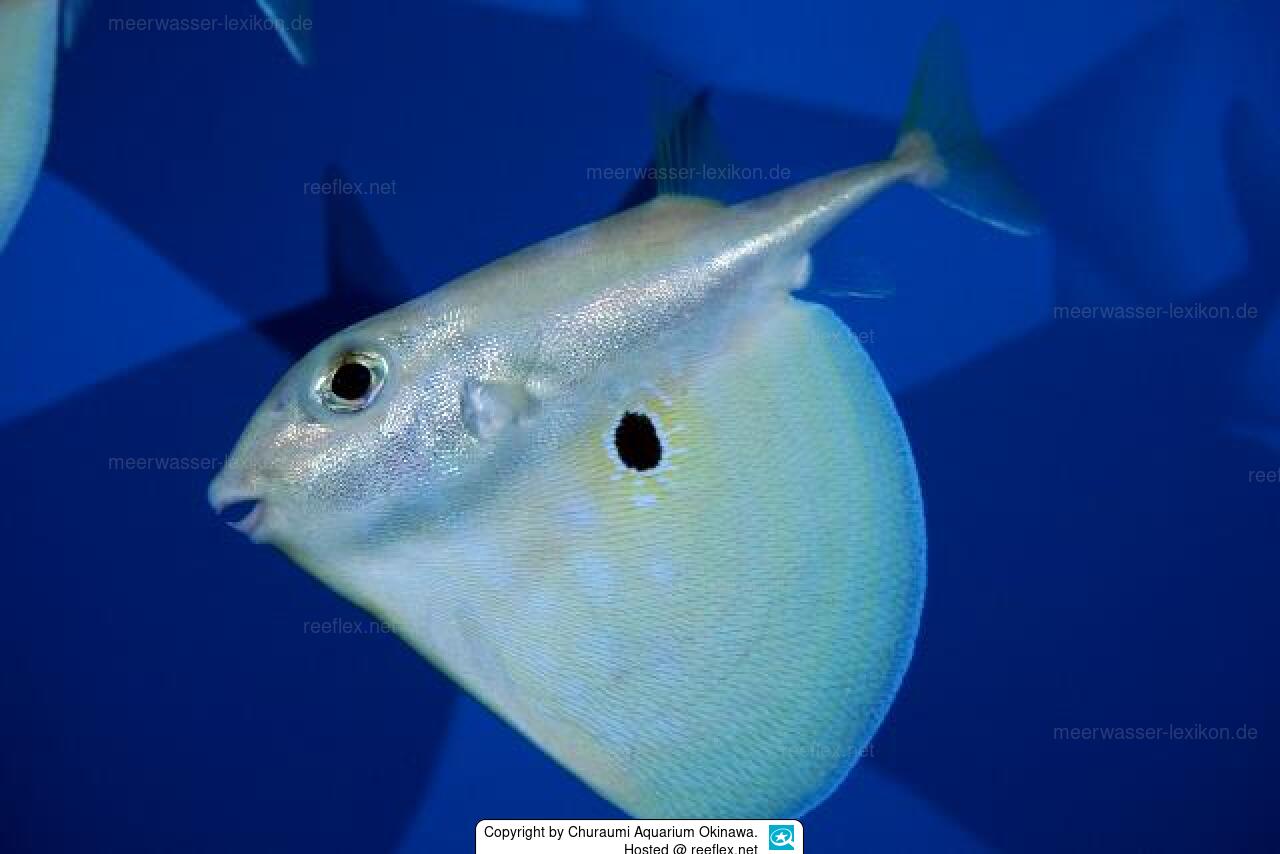Info
The puffer fish Triodon macropterus belongs to the monotypic family Triodontidae, the fish has three particularly strong front teeth.
The beak in the upper jaw is divided into two tooth plates, while the teeth in the lower jaw are fused into a single tooth plate.
The yellowish-brown pufferfish relative is notable for a large abdominal flap with a prominent black ocellus or "eyespot," a long slender pelvis that supports the abdominal flap,
Three-toed puffers usually swim with the flap retracted so that the large ocellus is visible only as a small black spot on the belly.
When in danger, the flap is extended to show the "eyespot" to deter predators.
The extended ventral lobe also very quickly makes the pufferfish appear much larger than it actually is.
When the ventral lobe is retracted into the ventral region, the alignment and raised ridges on the lower scales of the lobe form a seamless surface on the abdomen.
The Churaumi Aquarium in Okinawa, Japan, was the first place Triodon macropterus was successfully maintained in captivity.
Juvenile fish differs from adults in the structure of its viscera, especially in the presence of a very large, distended stomach, which is absent in the adult.
Synonyms:
Triodon bursaris Cuvier, 1829
Triodon bursarius Cuvier, 1829
Triodon macroptrus Lesson, 1831
Puffer fish can produce toxins such as tetrodotoxin and saxitoxin and accumulate them in the skin, gonads and liver.
The toxin tetrodotoxin, which is contained in the fugu, is 1000 times more toxic than cyanide and there is no antidote serum, death then occurs by respiratory paralysis
The degree of toxicity varies depending on the species, but also on the geographical area and season.
We recommend that you never prepare puffer fish yourself, as the risk of fatal poisoning is far too great.
If you still absolutely want to eat puffer fish meat (fugu), then the fish should only be slaughtered by a Japanese special chef with a license and several years of training.
Only the training of these special chefs can guarantee the correct slaughter, complete removal and proper disposal of all toxic parts of the fish.
The beak in the upper jaw is divided into two tooth plates, while the teeth in the lower jaw are fused into a single tooth plate.
The yellowish-brown pufferfish relative is notable for a large abdominal flap with a prominent black ocellus or "eyespot," a long slender pelvis that supports the abdominal flap,
Three-toed puffers usually swim with the flap retracted so that the large ocellus is visible only as a small black spot on the belly.
When in danger, the flap is extended to show the "eyespot" to deter predators.
The extended ventral lobe also very quickly makes the pufferfish appear much larger than it actually is.
When the ventral lobe is retracted into the ventral region, the alignment and raised ridges on the lower scales of the lobe form a seamless surface on the abdomen.
The Churaumi Aquarium in Okinawa, Japan, was the first place Triodon macropterus was successfully maintained in captivity.
Juvenile fish differs from adults in the structure of its viscera, especially in the presence of a very large, distended stomach, which is absent in the adult.
Synonyms:
Triodon bursaris Cuvier, 1829
Triodon bursarius Cuvier, 1829
Triodon macroptrus Lesson, 1831
Puffer fish can produce toxins such as tetrodotoxin and saxitoxin and accumulate them in the skin, gonads and liver.
The toxin tetrodotoxin, which is contained in the fugu, is 1000 times more toxic than cyanide and there is no antidote serum, death then occurs by respiratory paralysis
The degree of toxicity varies depending on the species, but also on the geographical area and season.
We recommend that you never prepare puffer fish yourself, as the risk of fatal poisoning is far too great.
If you still absolutely want to eat puffer fish meat (fugu), then the fish should only be slaughtered by a Japanese special chef with a license and several years of training.
Only the training of these special chefs can guarantee the correct slaughter, complete removal and proper disposal of all toxic parts of the fish.







 Okinawa-Churaumi-Aquarium, Japan
Okinawa-Churaumi-Aquarium, Japan



